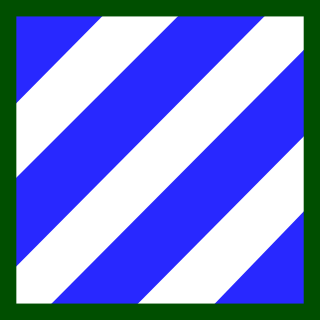
The 3rd Infantry Division (3ID) is a combined arms division of the United States Army based at Fort Stewart, Georgia. It is a subordinate unit of the XVIII Airborne Corps under U.S. Army Forces Command. Its current organization includes a division headquarters and headquarters battalion, two armored brigade combat teams, one infantry brigade combat team, one aviation brigade, a division artillery, a sustainment brigade and a combat sustainment support battalion along with a maneuver enhancement brigade. The division has a distinguished history, having seen active service in World War I, World War II, the Korean War, and the Global War on Terror. The Medal of Honor has been awarded to 61 members of the 3rd Infantry Division, making the division the most honored in the Army.

The 1st Infantry Division is a combined arms division of the United States Army, and is the oldest continuously serving division in the Regular Army. It has seen continuous service since its organization in 1917 during World War I. It was officially nicknamed "The Big Red One" after its shoulder patch and is also nicknamed "The Fighting First." The division has also received troop monikers of "The Big Dead One" and "The Bloody First" as puns on the respective officially sanctioned nicknames. It is currently based at Fort Riley, Kansas.

The 2nd Armored Division was an armored division of the United States Army. The division played important roles during World War II in the invasions of Germany, North Africa, and Sicily and in the liberation of France, Belgium, and the Netherlands. During the Cold War, the division was primarily based at Fort Hood, Texas, and had a reinforced brigade forward stationed in Garlstedt, West Germany. After participation in the Persian Gulf War, the division was inactivated in 1995.
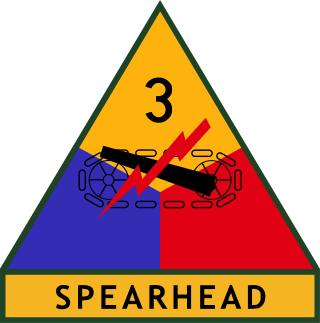
The 3rd Armored Division was an armored division of the United States Army. Unofficially nicknamed the "Third Herd," the division was first activated in 1941 and was active in the European Theater of World War II. The division was stationed in West Germany for much of the Cold War and also participated in the Persian Gulf War. On 17 January 1992, still in Germany, the division ceased operations. In October 1992, it was formally inactivated as part of a general drawing down of U.S. military forces at the end of the Cold War.
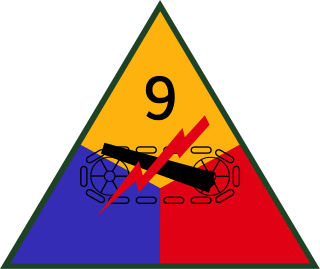
The 9th Armored Division was an armored division of the United States Army during World War II. In honor of their World War II service, the 9th was officially nicknamed the "Phantom Division."

The 91st Infantry Division (famously nicknamed as the "Wild West Division" with a "Fir Tree" as its Division insignia to symbolize its traditional home of the Far West) is an infantry division of the United States Army that fought in World War I and World War II. From 1946 until 2008, it was part of the United States Army Reserve. It was briefly inactivated from 2008 until 2010 when it was elevated back to a division size element as the 91st Training Division (Operations).

The 35th Infantry Division, formerly known as the 35th Division, is an infantry formation of the United States Army National Guard headquartered at Fort Leavenworth, Kansas.

The 102nd Infantry Division ("Ozark") was a unit of the United States Army in World War II. The unit is currently active as the 102nd Training Division (Maneuver Support).

The 88th Infantry Division was an infantry division of the United States Army that saw service in both World War I and World War II. It was one of the first of the Organized Reserve divisions to be called into federal service, created nearly "from scratch" after the implementation of the draft in 1940. Previous divisions were composed of either Regular Army or National Guard personnel. Much of the experience in reactivating it was used in the subsequent expansion of the U.S. Army.

The 92nd Infantry Division was an African-American, later mixed, infantry division of the United States Army that served in World War I, World War II, and the Korean War. The military was racially segregated during the World Wars. The division was organized in October 1917, after the U.S. entry into World War I, at Camp Funston, Kansas, with African-American soldiers from all states. In 1918, before leaving for France, the American buffalo was selected as the divisional insignia due to the "Buffalo Soldiers" nickname, given to African-American cavalrymen in the 19th century. The divisional nickname, "Buffalo Soldiers Division", was inherited from the 366th Infantry, one of the first units organized in the division.

The 93rd Infantry Division was a "colored" segregated unit of the United States Army in World War I and World War II. However, in World War I only its four infantry regiments, two brigade headquarters, and a provisional division headquarters were organized, and the divisional and brigade headquarters were demobilized in May 1918. Its regiments fought primarily under French command in that war. During tough combat in France, they soon acquired from the French the nickname Blue Helmets, as these units were issued horizon blue French Adrian helmets. This referred to the service of several of its units with the French Army during the Second Battle of the Marne. Consequently, its shoulder patch became a blue French helmet, to commemorate its service with the French Army during the German spring offensive.

The 9th Infantry Division is an inactive infantry division of the United States Army. It was created as the 9th Division during World War I, but never deployed overseas. In later years it was an important unit of the U.S. Army during World War II and the Vietnam War. It was also activated as a peacetime readiness unit from 1947 to 1962 at Fort Dix, New Jersey, and Fort Carson, Colorado, and from 1972 to 1991 as an active-duty infantry division at Fort Lewis, Washington. The division was deactivated in December 1991.

The 9th Cavalry Regiment is a parent cavalry regiment of the United States Army. It is not related to the 9th Kansas Cavalry Regiment of the Union Army. Historically, it was one of the Army's four segregated African-American regiments and was part of what was known as the Buffalo Soldiers. The regiment saw combat during the Indian and Spanish–American Wars. During Westward Expansion, the regiment provided escort for the early western settlers and maintained peace on the American frontier.

The 2nd Cavalry Division was a cavalry division of the United States Army.
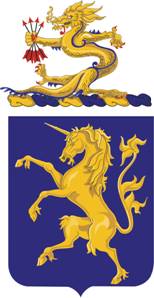
The 6th Cavalry is a regiment of the United States Army that began as a regiment of cavalry in the American Civil War. It currently is organized into aviation squadrons that are assigned to several different combat aviation brigades.

The 26th Infantry Division was an infantry division of the United States Army. A major formation of the Massachusetts Army National Guard, it was based in Boston, Massachusetts for most of its history. Today, the division's heritage is carried on by the 26th Maneuver Enhancement Brigade.
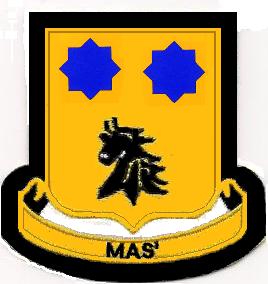
The 28th Cavalry Regiment (Horse) (Colored) was a short-lived African-American unit of the United States Army. The 28th Cavalry was the last horse-mounted cavalry regiment formed by the U.S. Army. The regiment was formed as part of the 2nd Cavalry Division in 1943 and inactivated in North Africa in 1944 without seeing combat.
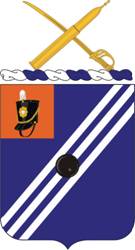
The 76th Field Artillery Regiment is a field artillery regiment of the United States Army. First formed as a cavalry regiment in 1916, the regiment was converted to field artillery in 1917, and served in Europe during World War I with the 3rd Division and as a separate battalion during World War II, as well as in peacetime at Fort Knox, KY, and Fort Devens, MA. Since 1959, the regiment has been a parent regiment under the Combat Arms Regimental System and the U.S. Army Regimental System, with regimental elements serving with the 3rd Infantry Division in Germany and Operation Iraqi Freedom, with the 7th Infantry Division in Korea, and in the Army Reserve. No regimental elements are currently active.

The 124th Cavalry Regiment is a United States Army cavalry regiment, represented in the Texas Army National Guard by 1st Squadron, 124th Cavalry, part of the 56th Infantry Brigade Combat Team at Waco.



















